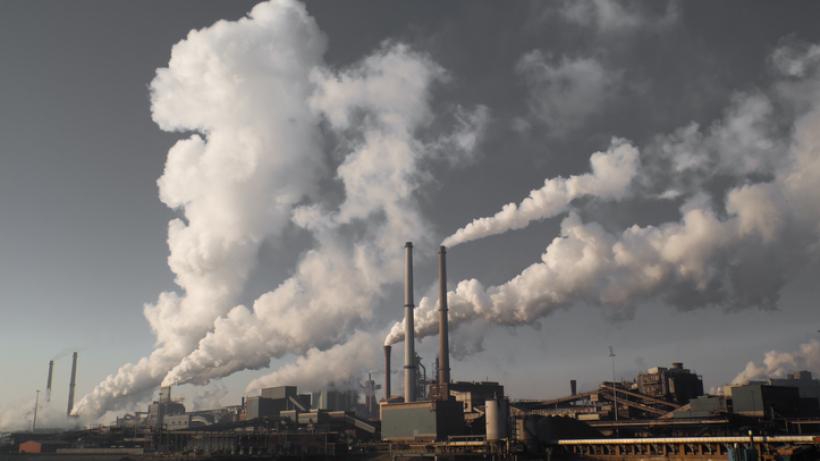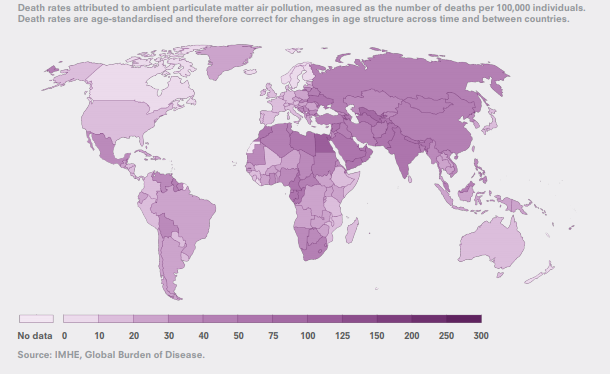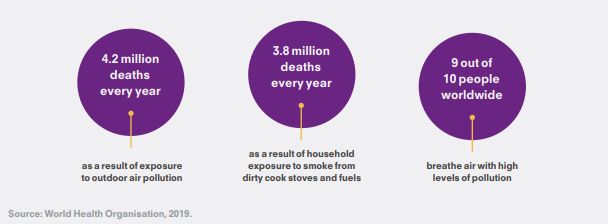
Suffocating prosperity: Air pollution and economic growth in developing countries
Air pollution is a silent killer that imposes substantial welfare and economic costs. Yet, people and governments underinvest in clean air. Policymakers must intervene with innovative solutions.
-
IGCJ7753-IGC-Pollution-WEB_.pdf
PDF document • 4.34 MB
Introduction
Historically, economic growth and the externalities of growth have been studied and dealt with separately. However, we are now reaching the point where the externalities of growth, such as air pollution, are holding back economic growth and thus policy decisions can no longer be made in isolation.
Air pollution is an externality of growth that has significant consequences at all levels; it affects individuals, firms, and governments. Approximately, nine out of ten individuals worldwide breathe air with high levels of pollution. Both outdoor and indoor air pollution have significant and long-lasting consequences. Over four million people die every year from exposure to outdoor air pollution and nearly as many perish from household exposure to dirty fuels, the overwhelming majority in developing countries (World Health Organisation, 2019).
In this brief, we look at the often severe economic impacts of air pollution in developing countries and what can be done to mitigate them. We discuss some reasons why individuals seem to have low demand for improving the quality of the environment and how these introduce a role for government intervention. We then layout policy instruments that can be used to curb pollution and discuss some ways that these can be adapted to developing country contexts.
Key messages
- Air pollution has severe economic and welfare costs. These costs are often excluded when designing new policies. Costs include direct impacts, through premature deaths, infant mortality, and mental health issues, and indirect impacts, through lost work hours, decreased productivity, and migration.
- Although demand appears to be low for a clean environment, government policy can improve welfare. Low demand is likely caused by market failures, including poor information, weak land and credit markets, and cognitive biases. This introduces a role for government intervention.
- Various policy tools are available for tackling pollution, but careful design is crucial. Market incentives – such as permit or tax systems – and mandates are two policy tools available for tackling air pollution if effectively designed.
- Policymakers need to innovate, tailoring traditional tools to their local market context. Solutions should address existing market failures by increasing transparency, improving incentives for monitoring and enforcement, and strengthening credit and land markets.
Key message 1 – Air pollution has severe economic and welfare costs. These costs are often excluded when designing new policies.
It is estimated that approximately 4.2 million people die every year as a result of exposure to outdoor air pollution and 3.8 million people die as a result of household exposure to smoke from dirty cookstoves and fuel (World Health Organisation, 2019). Although, the level of pollution is expected to increase over time and exposure to air pollution has had a far more devastating impact than exposure to malaria or unclean water, there has been relatively less awareness or policy action on this issue. If no new policies are introduced, the outlook is expected to worsen significantly (OECD, 2012).
One of the reasons air pollution has been less of a priority for governments is because it is often viewed as a ‘necessary evil’ for economic growth. Common belief is that if countries want to progress, they must produce more, transport more, and buy more – and thus, if we restrict burning of fossil fuels, then we must also forgo economic growth.
However, air pollution from these activities can potentially hold back economic growth. Policymakers must take this into account as air pollution can cause irreversible long-term damage. Health effects of air pollution have both a direct impact, through premature deaths, infant mortality, and mental health issues, and an indirect impact, through lost work hours, decreased productivity, and migration.
Direct impact: Mortality and morbidity
In terms of direct impact, there have been several studies on the economic cost of the health effects of air pollution. Keen and Altieri (2016) studied the effect of the health burden of South Africa’s current level of air pollution. They estimated that there were more than 21,000 premature deaths per year due to high levels of air pollution (approximately 7.4% of all deaths). These premature deaths cost the economy US$ 20 billion (2016). Another study, conducted in China, discovered an arbitrary Chinese policy that greatly increased air pollution in
one region, causing 500 million residents of Northern China to lose more than 2.5 billion years of life expectancy (Chen et al., 2013). To put it in a more global perspective, it is estimated that the welfare costs from premature deaths for the world were over US$ 3 trillion in 2010 and are anticipated to be over US$ 25 trillion by 2060 (OECD, 2016).
Figure 1: Death rate from ambient particulate air pollution

Not only does air pollution cause premature deaths, it also has a significant impact on infant mortality. A study examined the effect of air pollution on infant mortality and found that a one percent increase in carbon monoxide over a year results in a 0.23% increase in infant mortality. A one percent increase in particulate matter (PM) leads to a 0.42% increase in infant mortality (Arceo-Gomez, Hanna and Oliva, 2012). Studies have also linked both prenatal and post-natal air pollution exposure to increased infant mortality (Jayachandran, 2008; Currie and Neidell, 2005).
Air pollution also has significant mental health effects. A study examining the mental health consequences of air pollution discovered that an increase in average PM1 concentrations was associated with an increased probability of having a score that is associated with severe mental illness. Based on average health expenditures associated with mental illness and rates of treatment among those with symptoms, air pollution induced a total annual cost of US$ 22.88 billion in health expenditures (Chen, Oliva and Zhang, 2018).
Indirect impact: Productivity, hours worked, and migration
Premature deaths and health expenditures due to air pollution have a significant impact on the economy. However, air pollution also has several latent but pervasive consequences. One study looked into the relationship between pollution and lost work hours in Mexico City. The researchers discovered that the closure of a large refinery resulted in a 19.7% decrease in pollution and a 3.5% (1.3 hour) increase in the number of work hours per week. This meant that in the first year alone, the total gain in terms of labour income was approximately US$ 112 million (Hanna and Oliva, 2011).
Another study examined the effects of air pollution on white-collar workers who work primarily in-doors. It looked at workers in two call centres in China, tracked their daily calls, and discovered that the workers were, on average, 6% more productive on low pollution days than on high pollution days. The results show that not only does air pollution result in less working hours, but there is decreased productivity of each work-hour (Chang et al., 2016).
Researchers also looked into migration patterns and noticed that pollution contributed to migration flows in China. Well-educated people at the beginning of their professional careers are willing to incur potentially large costs to protect themselves from air pollution. This suggests that air pollution is driving talent out of major cities (Chen, Oliva and Zhang, 2017).
These studies show that air pollution has inescapable consequences for economic growth.2 Any cost-benefit analysis of policies that excludes the impact of air pollution will grossly underestimate the overall economic and welfare cost. Decreased mortality and health expenditure, increased total number of work hours, increased productivity of each work hour, and attracting talented people into cities will go a long way to boost economic growth. Therefore, investment in strategies to mitigate air pollution are essential for economic growth. Nevertheless, as we are understanding pollution’s high and pervasive costs more, it begs the question as to why so little has been done to address it?

Key message 2 – Although demand appears to be low for a clean environment, government policy can improve welfare.
Given the large health and economic costs of exposure to air pollution, we would expect to see households willing to pay significant sums to avoid these effects, through lobbying and self-protection (e.g., air purifiers and cleaner cook stoves). In reality, the evidence points to low willingness to pay (WTP) among those in the developing world.
For example, an International Growth Centre (IGC) funded study by Berry, Fischer, and Guiteras (2011) finds a median WTP for a water filter in Ghana of only US$ 2. Several other studies find similarly low demand for environmental quality (Kremer et al., 2011; Ito and Zhang, forthcoming). What causes this surprisingly low demand for environmental improvements? Low demand for environmental quality may simply be due to households valuing consumption more than environmental quality when they are poor. Yet this does not appear to be the whole story, since several studies fail to find a connection between assets and WTP (Berry, Fischer and Guiteras, 2011; Ashraf,
Berry, and Shapiro, 2010). Another possibility is that true WTP may be significantly higher than the values economic studies measure, due to market failures and cognitive biases that are common in developing countries:
- Information frictions: A large body of evidence suggests that a lack of information about pollution’s effects on health keeps WTP for quality improvements low. This implies that information campaigns can be effective in stimulating investment in protection against pollution (Jalan and Somanathan, 2008; Madajewicz et al., 2007; Pattanayak and Pfaff, 2009). The way information is delivered also matters – Bennear et al. (2013) found that households in Bangladesh that received complicated information about well contamination tended to make poor choices on water usage.
- Weak land and credit markets: Clarifying land rights and improving credit markets also appears to improve WTP for environmental improvements in developing countries by ensuring that consumers capture the benefits of their investments (Ali, Deininger and Goldstein, 2014; Guiteras, Levinsohn and Mobarak, 2015).
- Cognitive biases: Consumers in developing countries seem to be particularly vulnerable to biases when thinking about environmental protection. Specifically, the absence of effective environmental regulations requires citizens to put in repeated, individual effort to avoid exposure to pollution (Duflo, 2012; Mullainathan, 2006). In a world where individuals have limited time and energy to make decisions, this constant burden can be mentally and physically exhausting and thus cause individuals to express a lower WTP than its “true” value
(Vohs et al., 2008).
These frictions mean that individuals in developing countries are underinvesting in clean air. They introduce a major role for government policies to combat air pollution to improve social welfare.
Figure 2: Willingness to pay (WTP) estimates (USD)

Key message 3 – Various policy tools are available for tackling pollution, but careful design is crucial.
To tackle air pollution, policymakers in the developed world have turned to market-based incentives and command-and-control instruments. Their peers in the developing world can learn from these experiences and adapt them to their local context.
Market-based incentives
Market-based incentive systems, such as pollution taxes and tradable pollution permits, are the most cost-effective type of policy instrument used to reduce pollution, at least in theory. Policymakers can set either an optimal price (through a tax) or quantity (through a permit cap) for the target pollutant, and use market dynamics to ensure that the producers with the lowest costs of cutting pollution make the steepest cuts in emissions (Goulder and Parry, 2008). The empirical evidence from the United States (US) suggests that these tools can be effective (Schmalensee and Stavins, 2017).
Nevertheless, institutional weaknesses in developing countries, such as limited resources and low accountability, may make implementation infeasible (Laffont, 2005). India recently launched the world’s first emissions trading system which is projected to reduce particulate emissions by 29% (Greenstone et al., 2019). This programme will provide important lessons for other countries.
Command-and-control policies
Command-and-control measures, such as performance standards and technology mandates, are an alternative, less complex, class of instruments used to tackle pollution. Successful examples include India’s mandate on catalytic converters to reduce auto emissions and the global phase-out of leaded gasoline through an outright ban (OECD/UNEP, 1999).3 Meanwhile, the Mexico Clean Industry Program provides an example of a “hybrid” solution: Regulators implemented a voluntary certification programme together with emissions limits to reduce plant pollution (Foster and Gutierrez, 2013).
It is worth noting that poorly designed command-and-control measures can turn out to be counter-productive. For example, the Mexico City car ban, which keeps each car off the road for one day a week, has had no significant effect on air quality in the city, likely because drivers purchase additional older, “dirtier” vehicles (Davis, 2008). This case demonstrates that policymakers must study the anticipated effects of any policy, such as substitution behaviour, well in advance of rollout. Several additional considerations can make or break pollution regulations, regardless of the policy instrument chosen:
- Political economy: Corruption and opposition by interest groups can blunt the effectiveness of environmental policy (Burgess et al., 2012; Duflo, Greenstone, et al., 2013; Oliva, 2015). There are several options to address this risk. One is through policy design – for example, policymakers can give emission permits away for free when launching a permit scheme to earn political buy-in from industry groups. Another is by increasing transparency around pollution to increase public pressure on firms and state institutions – more on this below.
- Zoning: Policymakers should think about imposing zoning restrictions depending on how pollutants disperse in surrounding areas and the affected population densities. Possible solutions include applying different regulations by area or prohibiting “downstream” trades, though these complicate monitoring and enforcement (Goulder and Parry, 2008).
- Cross-border leakages: Leakages across regulatory borders are particularly problematic where polluters are mobile. Policymakers should coordinate with neighbouring jurisdictions to avoid spillovers. Kahn et al. (2015) show that the central government can play a role by incentivising regions to consider pollution spillovers, based on a natural experiment in China.
Key message 4 – Policymakers need to innovate, tailoring traditional tools to their local market context.
The diversity of issues across contexts and the important interaction effects between them mean that there is no one-size-fits-all policy approach. Nevertheless, several broad directions for policy emerge from the growing literature on environmental policy in the developing world.
1. Provide increased information and transparency. Informational asymmetries can be particularly acute in developing countries, where citizens face poor education systems and a lack of clear communications by authorities about health hazards (Greenstone and Jack, 2015). Communications campaigns can increase willingness to pay for a cleaner environment, which can translate into growing demand for regulations and increased pressure on governments to implement effective policies.
Greenstone and Hanna (2014) argue that this dynamic helps explain why air pollution regulations instituted in India since the 1970s have had a significant effect on reducing pollution levels, while those for water pollution have not. Improving transparency on the producer side may also help reduce pollution levels by enabling those affected to push for lower emissions. Building on an IGC project, an ongoing campaign aims to test this by implementing a public star-rating programme for large plants in Maharashtra, India.
Finally, new monitoring technology can help with enforcement. In another IGC-funded project, Duflo et al. (2018) show that a continuous emissions monitoring system (CEMS), providing improved information about emissions, can significantly reduce pollution levels. As the costs of the technology fall, more authorities should consider mandating the use of these monitoring systems by large polluters.
2. Improve incentives for monitoring and enforcement. Existing emissions control systems are often corrupted in developing countries. In Mexico City, Oliva (2015) shows that widespread cheating compromises the effectiveness of car emissions regulations and is not easily addressed by increased enforcement or penalties. Nevertheless, in other cases, some straightforward interventions can be effective in reducing pollution (see box below).
3. Improve credit and land-titling markets. Addressing imperfect credit and property title markets can also help increase willingness to pay for environmental quality. Studies in Rwanda and Bangladesh show that introducing more secure land titles and relaxing credit constraints, respectively, leads to increased investments in environmental protection (Ali, Deininger, and Goldstein, 2014; Guiteras et al., 2015). State institutions and microfinance lenders could play an important role in addressing these issues.
However, policymakers should beware of harmful interaction effects between market failures. For example, the presence of both credit constraints and environmental externalities can mean that increasing credit leads to more environmental degradation. Assuncao et al. (2013) find that credit constraints actually lowered deforestation rates in Brazil by limiting investments in farm animals requiring grazing land. This highlights the importance of policymakers working with researchers to estimate the effects of policy and staying open to changing course once those effects become clear.
Box 1: Improving monitoring and enforcement: Evidence from two IGC studies in India
Monitoring and enforcement of pollution standards is costly, particularly in developing countries where regulators tend to have low capacity, weak incentives, and limited technology. Nevertheless, targeted interventions to address specific market failures can reduce pollution at an acceptable cost.
In an IGC study, Duflo et al. (2013) showed that reforms to the environmental audit system can yield significant benefits. To address conflicts of interest by third-party environmental auditors in Gujarat, India, the researchers tested the effects of several targeted changes to the audit system, including randomising assignments and paying auditors from a central pool. They found that these led to significantly higher reductions in plant emissions at a reasonable cost – tentative estimates put the cost-benefit ratio at one to five.
In a related IGC study also in Gujarat, Duflo et al. (2018) examined the effects of regulator discretion and information on emissions. The researchers ran an experiment increasing resources for inspections and removing inspector discretion over which plants to check. They found that inspector discretion leads to three times more emissions reductions than random allocation, and that providing perfect information through technology (CEMS) leads to a further 30% emissions reduction. In other words, discretion is good, but good information is also important.
Policy recommendations
This brief has summarised the evidence on the large economic and health costs of air pollution and made a case for policy intervention in the presence of the market and institutional failures that are typical of developing countries. The key question for policymakers, then, is not whether but how to effectively clean up the toxic air that is so widespread in the developing world. The evidence for developing countries remains sparse, but several lessons emerge from the literature:
- Air pollution is an economic issue with both direct and indirect economic costs through factors such as productivity, hours worked, and migration. Policymakers should build these effects into cost-benefit analyses when deciding between competing priorities.
- Policymakers can choose between market incentives and command-and-control policies to tackle pollution. Taxes and tradable permits are more cost-effective, but performance standards may be easier to implement. A mix of the two approaches may also be suitable in some contexts.
- Regardless of the choice of policy instrument, any effective approach needs to account for the mobile nature of emissions. Zoning restrictions can help ensure that emissions are concentrated in areas with low population densities, while regional and cross-country coordination can mitigate pollution spillovers.
- Policymakers need to innovate to come up with solutions to the specific institutional failures in their contexts. Examples include: information campaigns on the harmful effects of air pollution, and public emissions monitoring and rating programmes to increase transparency; improved incentives for third-party auditors and increased discretion for inspectors to strengthen monitoring and enforcement performance of regulators; and reforms to land titling and increased access to credit to increase incentives for individuals to invest in environmental improvements.
- Interactions between multiple market failures can cause certain well-intended reforms to backfire. Policymakers should be ready to experiment, monitor outcomes, and iterate on policy reforms as needed – research partners can help with this.
References
Ali, Daniel Ayalew, Klaus Deininger, and Markus Goldstein. 2014. “Environmental and gender impacts of land tenure regularization in Africa: Pilot evidence from Rwanda.” Journal of Development Economics 262–275.
Arceo-Gomez, Eva O., Rema Hanna, and Paulina Oliva. 2012. “Does the effect of pollution on infant mortality differ between developing and developed countries? Evidence from Mexico City.” National Bureau of Economic Research.
Ashraf, Nava, James Berry, and Jesse M. Shapiro. 2010. “Can Higher Prices Stimulate Product Use? Evidence from a Field Experiment in Zambia.” American Economic Review 2383–2413.
Assuncao, Juliano, Clarissa Gandour, Romero Rocha, and Rudi Rocha. 2013. “Does Credit Affect Deforestation? Evidence from a Rural Credit Policy in the Brazilian Amazon.” Unpublished.
Behl, Manka. 2019. “Maharashtra govt to monitor 100 more polluting industries in state.” The Times of India. August 22. Accessed September 5, 2019.
Bennear, Lori, Alessandro Tarozzi, Alexander Pfaff, Soumya Balasubramanya, Kazi Matin Ahmed, and Alexander van Geen. 2013. “Impact of a randomized controlled trial in arsenic risk communication on household water-source choices in Bangladesh.” Journal of Environmental Economics and Management225–240.
Berry, James, Greg Fischer, and Raymond Guiteras. 2011. “Eliciting and Utilizing Willingness to Pay: Evidence from Field Trials in Northern Ghana.”International Growth Centre Working Paper E-2026-GHA-1.
Burgess, Robin, Matthew Hansen, Benjamin A. Olken, Peter Potapov, and Stefanie Sieber. 2012. “The Political Economy of Deforestation in the Tropics.” The Quarterly Journal of Economics 1707–1754.
Chang, Tom, Joshua Graff Zivin, Tal Gross, and Matthew Neidell. 2016. “The Effect of Pollution on Worker Productivity: Evidence from Call-Center Workers in China.” The National Bureau of Economic Research.
Chen, Shuai, Paulina Oliva, and Peng Zhang. 2018. “Air pollution and mental health: Evidence from China.” National Bureau of Economic Research.
Chen, Shuai, Paulina Oliva, and Peng Zhang. 2017. “The Effect of Air Pollution on Migration: Evidence from China.” The National Bureau of Economic Research.
Chen, Yuyu, Avraham Ebenstein, Michael Greenstone, and Hongbin Li. 2013. “Evidence on the impact of sustained exposure to air pollution on life expectancy from China’s Huai River policy.” Proceedings of the National Academy of Sciences of the United States of America 12936–12941.
Currie, Janet, and Matthew Neidell. 2005. “Air Pollution and Infant Health: What can we learn from California’s recent experience?” Quarterly Journal of Economics 1003–1030.
Davis, Lucas W. 2008. “The Effect of Driving Restrictions on Air Quality in Mexico City.” Journal of Political Economy 38–81.
Duflo, Esther. 2012. “Human Values and the Design of the Fight against Poverty.” Tanner Lectures on Human Values at Harvard University.
Duflo, Esther, Michael Greenstone, Rohini Pande, and Nicholas Ryan. 2018. “The Value of Regulatory Discretion: Estimates from Environmental Inspections in India.” Econometrica 2123–2160.
Duflo, Esther, Michael Greenstone, Rohini Pande, and Nicholas Ryan. 2013. “Truth-Telling By Third-Party Auditors and the Response of Polluting Firms: Experimental Evidence from India.” Quarterly Journal of Economics 1499–1545.
Field, Erica, Rachel Glennerster, and Reshmaan Hussam. 2011. “Throwing the Baby Out with the Drinking Water: Unintended Consequences of Arsenic Mitigation Efforts in Bangladesh.” Unpublished.
Foster, Andrew D., and Emilio Gutierrez. 2013. “The Informational Role of Voluntary Certification: Evidence from the Mexican Clean Industry Program.” American Economic Review 103 (3): 303–08.
Goulder, Lawrence H., and Ian W. H. Parry. 2008. “Instrument Choice in Environmental Policy.” Review of Environmental Economics and Policy 152–174.
Greenstone, Michael, and B. Kelsey Jack. 2015. “Envirodevonomics: A Research Agenda for an Emerging Field.” Journal of Economic Literature 5–42.
Greenstone, Michael, and Rema Hanna. 2014. “Environmental Regulations, Air and Water Pollution, and Infant Mortality in India.” American Economic Review 3038–72.
Greenstone, Michael, Rohini Pande, Nicholas Ryan, and Anant Sudharshan 2019. “The Surat Emissions Trading Scheme: A First Look at the World’s First Particulate Trading System.” Energy Policy Institute at the University of Chicago White Paper.
Guiteras, Raymond, James Levinsohn, and Ahmed Mushfiq Mobarak. 2015. “Encouraging sanitation investment in the developing world: A cluster-randomized trial.” Science 903–906.
Hanna, Rema, and Paulina Oliva. 2011. “The Effect of Pollution on Labor Supply: Evidence from a Natural Experiment in Mexico City.” National Bureau of Economic Research.
Ito, Koichiro, and Shuang Zhang. forthcoming. “Willingness to Pay for Clean Air: Evidence from Air Purifier Markets in China.” Journal
of Political Economy.
Jalan, Jyotsna, and E. Somanathan. 2008. “The importance of being informed: Experimental evidence on demand for environmental quality.” Journal of Development Economics 14–28.
Jayachandran, Seema. 2008. “Air Quality and Early-Life Mortality: Evidence from Indonesia’s Wildfires.” The Journal of Human Resources 916–954.
Kahn, Matthew E., Pei Li, and Dazuan Zhao. 2015. “Water Pollution Progress at Borders: The Role of Changes in China’s Political Promotion Incentives.” American Economic Journal: Economic Policy 223–42.
Keen, Samantha, and Katye Altieri. 2016. “The health benefits of attaining and strengthening air quality standards in Cape Town.” The Clean Air Journal.
Kremer, Michael, Jessica Leino, Edward Miguel, and Alix Peterson Zwane. 2011. “Spring Cleaning: Rural Water Impacts, Valuation, and Property Rights Institutions.” Quarterly Journal of Economics 145–205.
Laffont, Jean-Jacques. 2005. Regulation and Development. Cambridge University Press.
Madajewicz, Malgosia, Alexander Pfaff, Alexander van Geen, Joseph Graziano, Iftikhar Hussein, Hasina Momotaj, Roksana Sylvi, and Habibul Ahsan. 2007. “Can information alone change behavior? Response to arsenic contamination of groundwater in Bangladesh.” Journal of Development Economics 731–754.
Mobarak, Ahmed Mushfiq, Puneet Dwivedi, Robert Bailis, Lynn Hildemann, and Grant Miller. 2012. “Low demand for nontraditional cookstove technologies.” Proceedings of the National Academy of Sciences of the United States of America 10815–10820.
Mullainathan, Sendhil. 2006. “Better Choices to Reduce Poverty.” In Understanding Poverty, by Abjijit Vinayak Banerjee, Roland Benabou and Dilip Mookherjee, 379–88. Oxford and New York: Oxford University Press.
OECD. 2012. OECD Environmental Outlook. Paris: OECD Publishing.
OECD. 2016. The economic consequences of outdoor air pollution. Paris: OECD Publishing.
OECD/UNEP. 1999. Phasing Lead out of Gasoline: An Examination of Policy Approaches in Different Countries. Paris: OECD Publishing.
Oliva, Paulina. 2015. “Environmental Regulations and Corruption: Automobile Emissions in Mexico City.” Journal of Political Economy 686–724.
Pattanayak, Subhrendu K., and Alexander Pfaff. 2009. “Behavior, Environment, and Health in Developing Countries: Evaluation and Valuation.” Annual Review of Resource Economics 183–217.
Schmalensee, Richard, and Robert N. Stavins. 2017. “Lessons Learned from Three Decades of Experience with Cap and Trade.” Review of Environmental Economics and Policy 59–79.
Swartz, Jeff. 2016. China’s National Emissions Trading System: Implications for Carbon Markets and Trade. Geneva: International Centre for Trade and Sustainable Development.
Vohs, Kathleen D., Roy F. Baumeister, Brandon J. Schmeichel, Jean M. Twenge, Noelle M. Nelson, and Dianne M. Tice. 2008. “Making Choices Impairs Subsequent Sef-Control: A Limited-Resource Account of Decision Making, Self-Regulation, and Active Initiative.” Journal of Personality and Social Psychology883–98.
World Health Organisation. 2019. Air Pollution. 04 18.
Note: Bold text denotes IGC-funded studies




